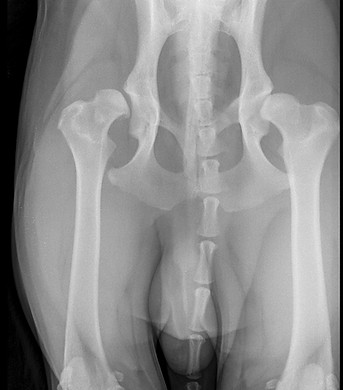Ewing Walker Orthopaedic Vet Northern Ireland
Vet Ortho Referrals at Portadown & Richhill, Co Armagh
028 38 871942
Orthopaedic & Spinal Referrals

Hip Dysplasia

Hip Dysplasia
Treatment Options and Methods for Hip Dysplasia in dogs:
Many dogs with pain and lameness associated with hip dysplasia can be effectively managed with conservative methods.
Conservative methods include: weight management, moderation of excessive exercise/activity, providing warm comfortable bedding, and the use of non-steroidal anti-inflammatory drugs, physical rehabilitation, and oral supplements as needed.
If conservative methods are ineffective or in some young dogs with hip dysplasia corrective or salvage hip surgery may be considered.
Early corrective surgery to preserve the existing hip joint may be suitable- for example Triple Pelvic Osteotomy (TPO) or Juvenile Pubic Symphysiodesis (JPS). After this growing phase surgical options are restricted to Total Hip Replacement (THR) or Femoral Head and Neck Excision (FHO)
TPO (Triple pelvic osteotomy) surgery for hip dysplasia in dogs.
Hip dysplasia is a common cause of lameness in young large & giant breed dogs. If detected early before the closure of the growth plates corrective Triple Pelvic Osteotomy (TPO) or Juvenile Pubic Symphysiodesis (JPS) surgery may be performed to improve the coverage of the femoral head by the acetabulum. This is usually done by a triple pelvic osteotomy (TPO) which for best results should be performed at 5-9 months of age and must be done before the onset of radiographic DJD or significant articular cartilage damage. The pelvis is cut in three places (osteotomy) and a plate applied to the ilial osteotomy site to rotate the acetabulum between 20-30 degrees. (Greater angles are not recommended). Some improvement is seen immediately in the post op radiographs however significant improvement is usually seen over the following 6 months as remodelling & growth occurs.



Utilising the New Generation plates


Developments in plate technology and locking screws have aided with plate and placement
Accurate case selection is essential for a good outcome following TPO surgery in dogs. Not all dogs with hip dysplasia are suitable- dogs with mild to moderate hip dysplasia with little or no radiographic remodelling or damage to the DAR aged 5-9 months are the best candidates. Arthroscopy of the hip is useful to determine if cartilage damage is already present. A positive ortalani sign, with a deep acetabulum with minimal filling and angles of reduction of <30 and angles of subluxation of around 10 degrees are best. Dogs with more severe HD or evidence of OA are not suitable & may be more suitable for conservative management and later total hip replacement if indicated.
If early corrective surgery is not performed, particularly in large breed dogs, which may also be overweight development of severe arthritis is likely. A femoral head & neck osteotomy (FHO) may have to performed to reduce the pain.

Femoral head & neck osteotomy FHO or Total hip replacement THR for end stage hip dysplasia HD. In dogs which have severe hip pain and the quality of life is decreased, and if conservative methods are not effective, surgical treatment should be considered
A total hip replacement (THR) may also be considered in medium to large dogs.



Triple pelvic osteotomy surgery
Good case selection:
4 Year follow up radiographs from a Labrador with bilateral hip dysplasia following a bilateral staged TPO surgery
Bilateral Triple pelvic osteotomy with good acetabular coverage at a four year follow up radiograph. There was no lameness and no radiographic evidence of DJD visible in either hip in this case. Unfortunately no treatment will fully prevent osteoarthritis.
These cases from 2002-2006 period utilised the older VI plate. More recent cases have benefited from the evolution of the Slocum, New Generation locking and Synthes DPO / TPO plates.
Severe bilateral hip dysplasia with development of advanced DJD in a dog which did not have a triple pelvic osteotomy TPO
8 Year follow up radiographs from a Newfoundland with bilateral hip dysplasia following a bilateral staged TPO surgery in 2006
"Dear Ewing,
You may not remember me but I'm sure you'll remember Breeze. My apologies for not bringing her back for follow-up X-rays; you're quite a distance away.
The only time Breeze has been under anaesthetic again was a few months ago, so I took the opportunity then to ask for an X-ray of her hips. I said that I'd be copying to you.
Not the normal view but you can see why my vet was impressed; I was delighted but not overly surprised. She's been very sound (positively athletic by Newfie standards!) for all these years and still no signs of pain or stiffness.
I'll be eternally grateful for your advice and skills...
So this is by way of a very inadequate thank you.
D B Hillsborough"


THR-TPO combinations
In the case on the left, we performed a Left TPO when this dog was 9 months old, with the intention of performing a Right THR on the more severely affected Right hip when it reached full skeletal maturity and adult bone size.
An example of this is in the case on the right- note 1 THR and 1 TPO surgery. We had performed this staged bilateral surgery approx. 10 years previously.


Severe end -stage hip osteoarthritis in a dog with bilateral hip dysplasia.
Options for cases like this include:
1. Conservative medical management if pain can be controlled with medical therapies, exercise control and weight management,
2. Salvage surgical treatment by Total Hip Replacement (THR) or Femoral Head and Neck (FHO).
